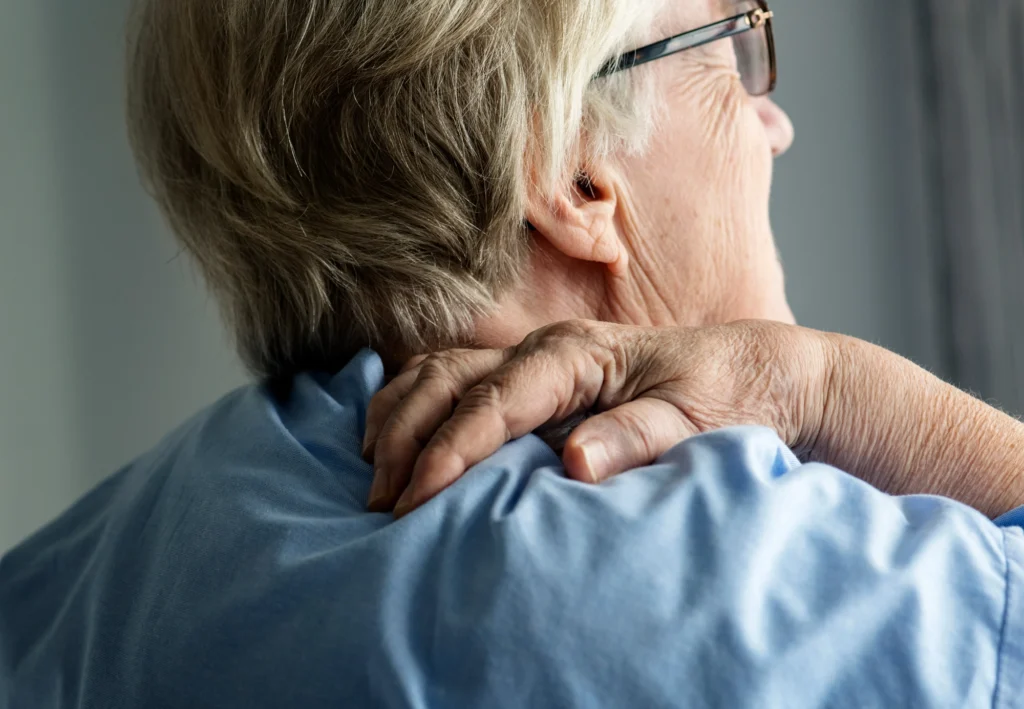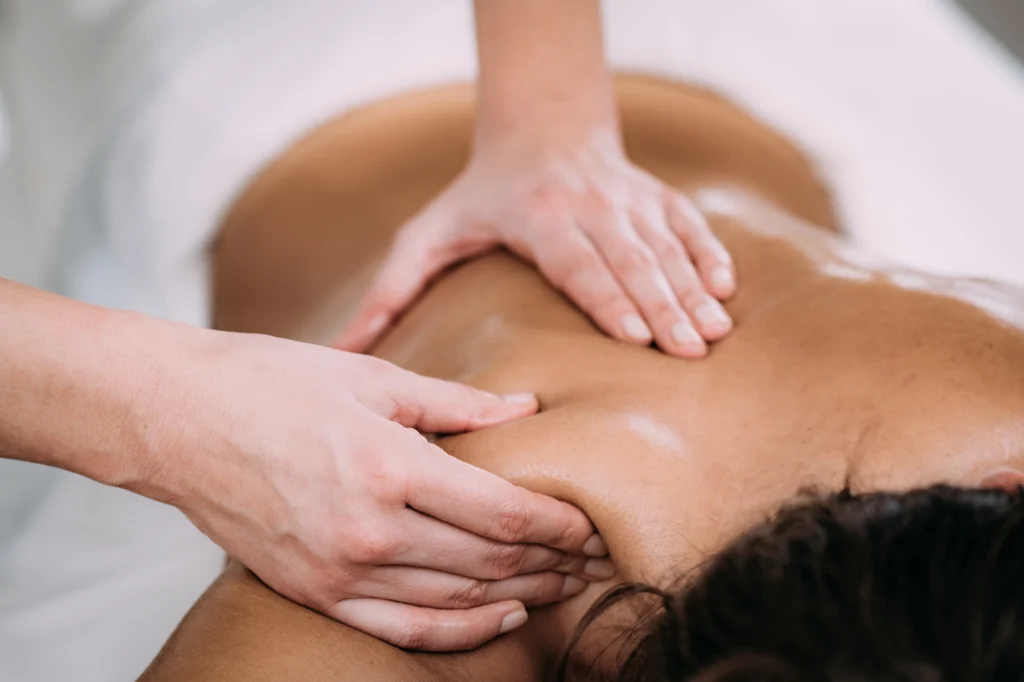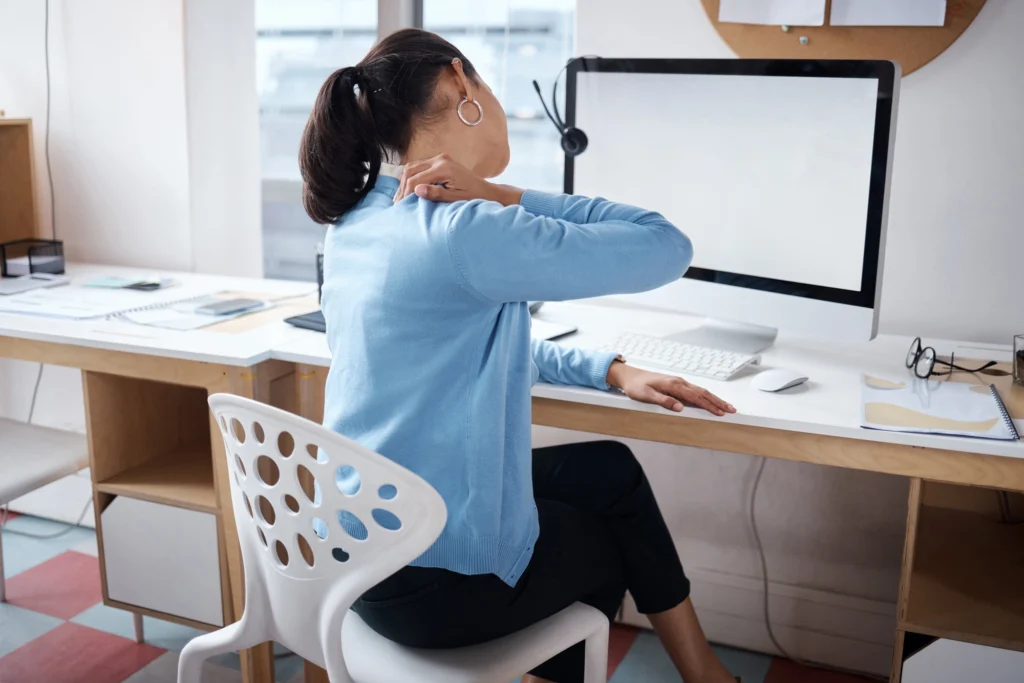
Table of Contents
ToggleYou may experience pain under your shoulder blade for a variety of reasons.
Your thoracic spine is made up of 12 vertebrae, which form the middle section of your back. This part of your spine extends from the base of your neck to the bottom of your rib cage. It protects many vital organs, including the lungs and heart.
When you experience shoulder blade pain, it can be due to structural changes in this area or a condition affecting your thoracic spine that requires treatment.
The most common cause of shoulder blade pain is muscle strain. The muscles that run along the sides of your spine can become strained when you lift something too heavy or overexert yourself, causing them to pull on their attachment points in your back.
Other causes of shoulder blade pain include:
A herniated disc occurs when a part of an intervertebral disc pushes through its outer covering and presses against nearby nerves or spinal cord tissue. It may cause mild to severe pain in your back and/or legs, depending on where it’s located; however, this type of injury usually doesn’t cause any numbness or tingling sensations (as might occur with sciatica).
In addition to sharp pains that come and go during activity, people with this condition may experience dull aches throughout the day as well as stiffness after sitting for long periods of time.
Spinal stenosis is a compression disease that occurs when the spinal column narrows, causing pressure on the nerves. It usually affects people over 50, who suffer from arthritis and disk degeneration in the spine.
Spinal arthritis is a progressive, degenerative condition that can affect the neck, back and spine. The disease usually starts with small amounts of cartilage damage in one or more joints. As the cartilage wears away over time, the bones beneath them begin to rub against each other causing inflammation, pain and stiffness.
Osteoarthritis (OA) is a joint disease affecting the cartilage that cushions the joints of the body and allows for smooth movement. The cartilage, which normally covers and protects the bones at the joints, breaks down over time with repeated use or from an injury or other event. The most common sites of OA include: weight-bearing joints such as knees and hips; fingers and hands; shoulders, elbows, spine and neck; and ankles, feet and toes.
Tumors that develop within bones such as cancers (melanoma), lymphomas (lymph node cancers), osteosarcoma (bone cancer) and chondrosarcoma (cartilage cancers).
Overuse injuries caused by repetitive motions like typing at work or playing sports regularly without taking breaks between sessions, lifting boxes.
Cervical herniated discs occur within cervical vertebrae–the bones located closest to your head–and can result from trauma sustained during auto accidents involving head impact injuries like whiplash syndrome.
Spine compression fractures: Conditions such as osteoporosis and spinal tumors can weaken the vertebrae in your spine. Once weakened, they may no longer be able to support it as you go about your daily activities—so compression fractures could occur spontaneously when you perform everyday activities like walking or lifting something heavy.
It’s important to remember that back pain under the shoulder blade is not a serious condition, and it can often be treated with simple home remedies.
If you have been diagnosed with a muscle strain or sprain, try these steps:
If you have a muscle spasm or injury, ask someone to massage the painful area. Massaging muscles can help relax them and get more blood flowing where it’s needed most—promoting healing.

If you spend a lot of time hunched over and looking down or sitting to one side —while working behind a desk or reading from a cell phone, for example— there are chances that you have developed poor posture, weakening your muscles and placing pressure on spinal discs, muscles, and ligaments.
This can lead to structural changes in the spine, which can cause pain in the shoulder blades as well as other areas of your body.
Back pain under the shoulder blade is often caused by a condition affecting your thoracic spine.
The thoracic spine is the part of the spine that sits between the shoulder blades.
Arthritis in the thoracic spine may cause pain around your shoulder blades, either because of radiating pain, or tense muscles.
In these cases, and many others, exercise, including stretching and strengthening, may help alleviate your pain and provide adequate support to the areas of the body that need it.
A compression fracture of the spine is a serious injury that occurs when you have a fall or heavy impact on your back. This may occur when the bones in your spine are crushed or compressed.
This type of fracture can be caused by osteoporosis, which causes brittle bones that break more easily than healthy bones.
Compression fractures can also be caused by osteogenesis imperfecta, which is a genetic disorder that causes weak bones.
A compression fracture can cause pain in your lower back and shoulder blade area. You may also have numbness and tingling in one or both legs if there is nerve damage associated with your compression fracture.
In some cases, you may not feel any pain at all until after several days or weeks when swelling develops around the area where your bone broke.
A spinal fracture due to osteoporosis (weak bones) is commonly referred to as a compression fracture, but can also be called a vertebral fracture, osteoporotic fracture, or wedge fracture.
A combination of the next symptoms from vertebral fractures can also lead to changes in the individual’s self-image, which in turn can adversely affect self-esteem and ability to carry on the activities of daily living:

If you’re experiencing back pain under your shoulder blade, it’s important to know that there are many different causes for this type of pain. Your doctor will need to examine you and ask about your symptoms, medical history and other factors in order to help determine what may be causing the pain.
If necessary, the doctor may order tests such as X-rays or MRI scans (magnetic resonance imaging). These tests can show if there is any damage to the bones or soft tissues in the spine area.
Your doctor might also refer you to another specialist such as an orthopedic surgeon if they think surgery might be needed on one or more areas of your spine (spinal column).
If you’re experiencing shoulder blade pain, it’s important to understand the cause. Poor posture can cause structural changes to the spine, which in turn can lead to compression fractures and other ailments.
If you suspect that your shoulder blade pain is due to poor posture or a spine injury, talk to your doctor about treatment options.
If you have been diagnosed with a spinal compression fracture or another serious condition, we recommend seeking immediate medical attention—you may need surgical intervention or other treatments such as physical therapy.
GET IN TOUCH +
285 Sills Road
Building 5-6, Suite E
East Patchogue, NY 11772
(631) 475-5511
184 N. Belle Mead Road
East Setauket, NY 11733
(631) 675-6226
GET IN TOUCH +
285 Sills Road
Building 5-6, Suite E
East Patchogue, NY 11772
(631) 475-5511
184 N. Belle Mead Road
East Setauket, NY 11733
(631) 675-6226
SUBSCRIBE TO OUR NEWSLETTER +
Send us a Google review. Click this link and let us know how we did!
Review us on Yelp too.